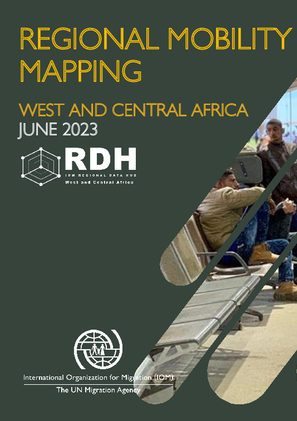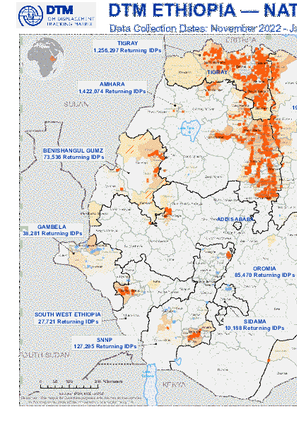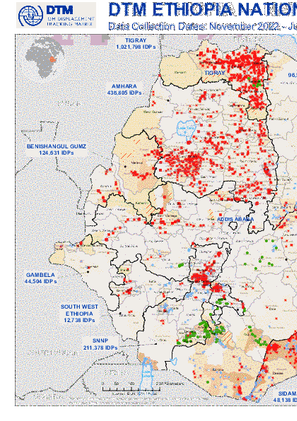-
Countries
-
Data and Analysis
-
Special Focus
-
Crisis Responses
Contact
DTM Sudan, DTMSudan@iom.int
Location
Sudan
Activity
- Mobility Tracking
- Baseline Assessment
Period Covered
May 19 2023 -Aug 20 2023
The current total estimate of recently displaced individuals across Sudan has reached 3,601,593 Individuals (719,521 Households). The current assessment has observed the IDP caseload in all of Sudan’s 18 states. The highest proportions of IDPs have been observed in River Nile (14.17%), East Darfur (10.62%), Northern (10.08%), Sennar (7.97%), and White Nile (7.86%). Field teams report that the IDPs observed were originally displaced from eight states. The majority (2,729,777 IDPs, 75.79%) have been reportedly displaced from Khartoum state; followed by North Darfur (7.75%), South Darfur (7.12%), Central Darfur (4.09%), West Darfur (3.40%), South Kordofan (1.37%), North Kordofan (0.47%), Aj Jazirah (0.01%)
DTM Sudan estimated, before the crisis, that Sudan had approximately 3.8 million IDPs - the majority of whom (an estimated 79%) were based in Darfur and in severe need of humanitarian assistance (HNO 2023). Due to the ongoing nature of the fighting, many of the reported areas remain largely inaccessible to the field teams. DTM Sudan also estimates that approximately 2.99% of the IDP caseload are non-Sudanese nationals.
In addition to the internal displacement, the conflict in Sudan has caused the Mixed Cross-Border Movements of 1,040,883 individuals into neighbouring countries namely Egypt, Libya, Chad, Central African Republic, South Sudan and Ethiopia. 68% of arrivals tracked in those countries were Sudanese nationals and 32% estimated foreign nationals and returnees. The majority of arrivals were reported in Chad (41%), Egypt (27.4%), and South Sudan (22.2%).
Population Groups
Survey Methodology
Unit of Analysis Or Observation
Type of Survey or Assessment
Keywords
Geographical Scope
Administrative boundaries with available data
The current dataset covers the following administrative boundaries

Contact
DTM Europe, DTMMediterranean@iom.int
Language
English
Location
Latvia
Period Covered
Apr 01 2023
Jun 30 2023
Activity
- Survey
- Flow Monitoring
This report is based on a survey of displacement patterns, needs and intentions conducted by IOM’s Displacement Tracking Matrix (DTM) in the countries included in the Regional Response Plan for Ukraine in 2023: 6 countries neighbouring Ukraine – Belarus, Hungary, Poland, Republic of Moldova, Romania and Slovakia – and other 5 countries particularly impacted by the arrivals of refugees from Ukraine since the start of the war in February 2022 – Bulgaria, Czechia, Estonia, Latvia and Lithuania. The analysis presented in this report is based on data collected between April and June 2023.
Key Findings:
• Top oblasts of origin: Donetska (25%), Khersonska (21%), Zaporizka (17%) and Luhanska (13%).
• Intentions to move: Latvia is a transit country for many refugees from Ukraine. The majority planned to move to another country (58%), where Top 3 were Poland, Russian Federation and Germany. Others wanted to move to a different location in Ukraine (29%) or move to their place of origin in Ukraine (8%).
• Employment status: unemployed and looking for a job (40%), employed (20%), retired (25%), unemployed and not looking for a job (4%), daily worker (3%).
• Top needs:* housing (36%), cash support (36%), employment (34%), medical needs (23%), information (18%).
• Top areas of assistance received:* food products (74%), financial support (40%), housing (35%), personal hygiene and sanitary supplies (16%).
* more than one answer possible
The development and implementation of policies and programmes in West and Central Africa promoting safe, orderly and humane migration require a better understanding of human mobility in the region.
Human mobility in the region take many different forms. Transhumance, seasonal migration conducted during the harvesting season, travel during religious festivities, tourism, economic migration to North Africa and Europe, the search for employment in the mining industry, forced displacements due to conflict, natural disasters or climate-related migration, rural exodus, are all examples of movements observes in West and Central Africa and show the many faceted nature of mobility in the region.
This document is an attempt to provide a dynamic and regularly updated portrait of mobility within, from and to West and Central Africa regionon for Migration (IOM), the United Nations Department of Economic and Social Affairs (UNDESA) and the United Nations High Commissioner for Refugees (UNHCR).
The maps contained in this document are not only meant to inform on ongoing mobility patterns, but also provide information to support direct programming (protection of migrants, management of transhumance flows, support to safe returns of displaced people) and policy.
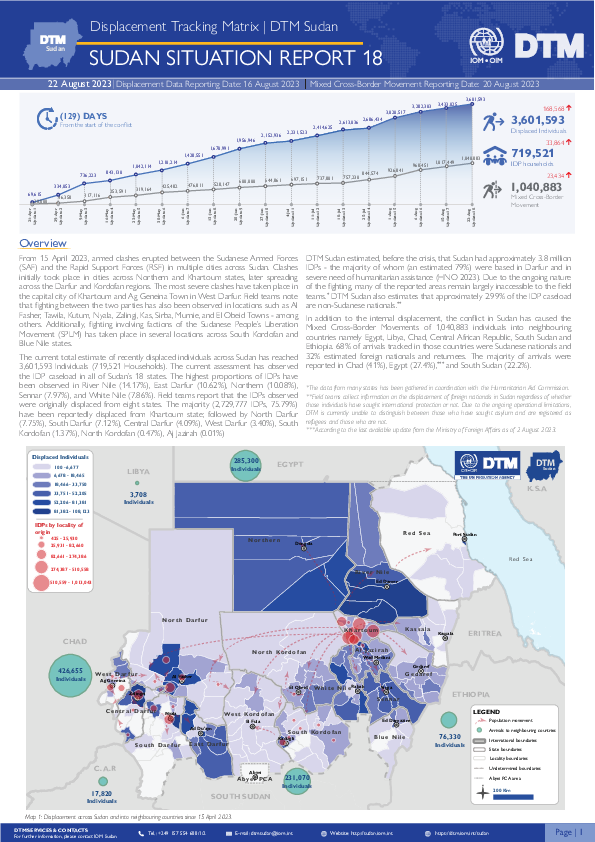
Contact
DTM Sudan, DTMSudan@iom.int
Language
English
Location
Sudan
Snapshot Date
Aug 16 2023
Activity
- Mobility Tracking
- Baseline Assessment
Overview
From 15 April 2023, armed clashes erupted between the Sudanese Armed Forces (SAF) and the Rapid Support Forces (RSF) in multiple cities across Sudan. Clashes initially took place in cities across Northern and Khartoum states, later spreading across the Darfur and Kordofan regions. Since Situation Report 17, the field team has reported outbreaks of violence across Kadugli locality in South Kordofan, Nyala Janoub locality in South Darfur, and Al Fasher locality in North Darfur.
Highlights
- The current total estimate of recently displaced individuals across Sudan has reached 3,601,593 Individuals (719,521 Households).
- The current assessment has observed the IDP caseload in all of Sudan’s 18 states.
- The highest proportions of IDPs have been observed in River Nile (14.17%), East Darfur (10.62%), Northern (10.08%), Sennar (7.97%), and White Nile (7.86%).
- Field teams report that the IDPs observed were originally displaced from eight states. The majority (2,729,777 IDPs, 75.79%) have been reportedly displaced from Khartoum state; followed by North Darfur (7.75%), South Darfur (7.12%), Central Darfur (4.09%), West Darfur (3.40%), South Kordofan (1.37%), North Kordofan (0.47%), Aj Jazirah (0.01%).
- DTM also reports the Mixed Cross Border Movements of 1,040,883 individuals into neighbouring countries.
Between April and June 2023, IOM DTM deployed Site Assessment (SA) Round 33 and Village Assessment Survey (VAS) Round 16, carrying out a multisectoral location assessment in Tigray region, and a figure update in selected high mobility locations across the rest of Ethiopia. The November 2022 - January 2023 data (Round 32 for SA and Round 15 for VAS) was compiled with the April - June 2023 data (Round 33 for SA and Round 16 for VAS) to consolidate national IDP and returning IDP figures updated to June 2023. The locations assessed during both rounds of data collection are not duplicated in the consolidated figures. The National Returns Map visualizes locations of return, density of return caseload, primary reasons for initial displacement, estimated return figures, and access constraints.

Contact
DTM DRC, iomdrcdtm@iom.int
Language
English
Location
Democratic Republic of the Congo
Period Covered
Jul 25 2023
Aug 03 2023
Activity
- Registration
Ce tableau de bord présente les éléments clés qui ressortent des résultats consolidés des opérations d’enregistrement dans la province du Tanganyika menées par l’OIM par le biais de sa matrice de suivi des déplacements (DTM) en coopération avec la Division des Affaires Humanitaires (DIVAH), du 25 juillet au 03 août 2023 dans 3 sites (Kaseya, Kabiyanga, et Tchofa) dans le territoire de Kongolo. La grande partie de la population enregistrée est comprise dans la catégorie d’âge de 18 à 59 ans, ce qui représente 57 pour cent du total soit (6 576 personnes). Environs 50 pour cent (5 755) de ménages enregistrés sont arrivées dans les sites au quatrième trimestre de l’année 2022 en particulier. La majorité de ménages (75%, soit 8 711 ménages) proviennent du territoire de Kabambare, 22 pour cent (2 606) de Kabalo, 1 pour cent (97) de Kongolo et 2 pour cent (218) d’autres localités.
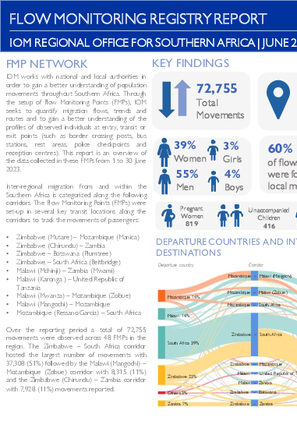
Contact
DTM DRC, iomdrcdtm@iom.int
Language
English
Location
Democratic Republic of the Congo
Period Covered
Jul 05 2023
Jul 20 2023
Activity
- Registration
Ce tableau de bord présente les éléments clés tirés des résultats consolidés des opérations d’enregistrement au Nord-Kivu menées par l’OIM entre le 5 et le 20 juillet 2023 dans 104 sites/centres collectifs dans et autour de la ville de Goma. La DTM a recueilli auprès des personnes déplacées des informations sur les ménages et les individus, notamment des données démographiques, la cause du déplacement, le lieu d’origine et la date d’arrivée afin de fournir des données fiables sur la démographie des populations déplacées vivant dans les sites. La majorité (71%) des ménages enregistrés sont arrivées dans la localité en 2022, en particulier au quatrième trimestre. Parmi les ménages pour lesquels des informations sur la provenance étaient disponibles, 40 pour cent provenaient du territoire de Rutshuru, y compris le territoire de Nyiragongo (37%) et Masisi (23%). Moins d’un pour cent des ménages provenaient d’autres localités. Les attaques des groupes armés sont responsables du déplacement de la majorité (72%) des individus. Presque la totalité (99.7%) des ménages ont été déplacées à cause des attaques des groupes armées.
Between April and June 2023, IOM DTM deployed Site Assessment (SA) Round 33 and Village Assessment Survey (VAS) Round 16, carrying out a multisectoral location assessment in Tigray region, and a figure update in selected high mobility locations across the rest of Ethiopia. The November 2022 - January 2023 data (Round 32 for SA and Round 15 for VAS) was compiled with the April - June 2023 data (Round 33 for SA and Round 16 for VAS) to consolidate national IDP and returning IDP figures updated to June 2023. The locations assessed during both rounds of data collection are not duplicated in the consolidated figures. The National Displacement Map visualizes locations of displacement, density of displacement caseload, primary reasons for displacement, estimated displacement figures, and access constraints.
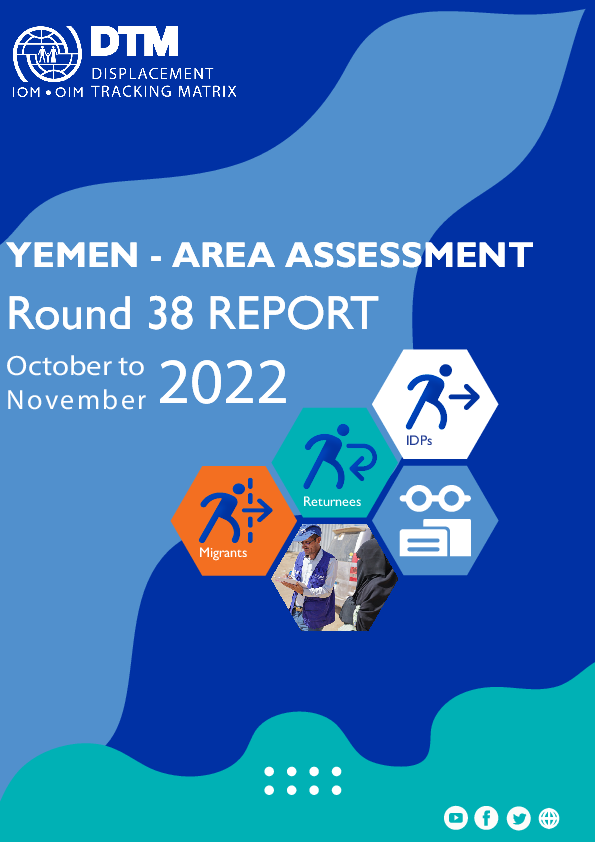
Contact
DTM Yemen, iomyemendtm@iom.int
Language
English
Location
Yemen
Period Covered
Oct 01 2022
Nov 30 2022
Activity
- Migrants presence
- Mobility Tracking
This summary presents the findings of the 38th round of Area Assessment (Mobility Tracking) undertaken by IOM’s Displacement Tracking Matrix to establish a new baseline on the number of Internally Displaced Persons (IDPs), IDP returnees and migrants in Yemen.
Findings are currently limited to the country’s south controlled by the internationally recognized government (IRG). Data was collected by 153 enumerators through an extensive network of Key Informants (KIs) within the operational area. In the Yemen context, the practice for field teams is to select KI representatives of both the host and target communities while adhering to the humanitarian principles of humanity, neutrality, impartiality and operational independence.
This ensures that the selected KIs are the most relevant and appropriate individuals to ensure the successful implementation of the exercise. This round 3,633 KIs were interviewed to collect the data, of whom seven per cent or 270 were female and 93 per cent or 3,363 were male. Among the main outputs of the Sub-Area Assessment, is a list of locations where IDPs, returnees and / or migrants are present that can be used to inform more detailed assessments at the location level, including the annual Multi-Cluster Location Assessment (MCLA). DTM field staff, along with KIs, use the Sub-Area Assessment tool to capture locations, which are matched to the identified locations in the OCHA Common Operational Dataset (P-Codes).
Using a standardized and structured approach to the selection of KIs is a key step to ensuring that data collected in the Sub-Area Assessment is comprehensive and comparable across the different teams. The Sub-Area Assessment tool is used to verify and update the baseline information in regular intervals (rounds). Deployed DTM staff, called enumerators, are in regular communication with their KI network throughout each month and work continuously to maintain and expand this network to further triangulate the displacement statistics collected. The forms and definitions used can be accessed here. Please note that findings represent the results of a pilot round in this new format. The number of migrants indicated in this report represents a snapshot in time for a transient population located in areas data collection teams could access. Findings for Aden Governorate are not supported by Yemen’s Central Statistical Organization (CSO) and the Executive Unit for IDP Camps Management (ExU) for this round but will be further verified in the subsequent round of the Area Assessment in 2023. The ExU maintains that the current number of IDPs living in Aden stands at 145,857 individuals.
In a total of 394 sub-districts, IOM recorded a presence of IDPs in 364 sub-districts (92%), a presence of IDP returnees in 182 sub-districts (46%) and a presence of migrants in 74 sub-districts (19%).

Contact
Angélica Madrigal amadrigal@iom.int
Language
Spanish
Location
Costa Rica
Period Covered
Jan 01 2023
May 31 2023
Activity
- Survey
- Registration
- Flow Monitoring
Costa Rica, al igual que los demás países de la región centroamericana, se ha caracterizado por ser un corredor migratorio para personas que transitan de manera terrestre desde el sur hasta el norte de América y que tienen como destino los países del norte del continente. Este flujo en situación de movilidad por las Américas se encuentra compuesto principalmente por personas de la República Bolivariana de Venezuela, Cuba, Haití, Ecuador, así como personas provenientes de otros países de Suramérica, África y Asia.
Sixaola se ubica en la frontera sur de Costa Rica, es el distrito dos del cantón Talamanca, en la provincia Limón. Tanto Limón como Sixaola forman parte de las rutas migratorias alternas poco utilizadas por las personas en situación de movilidad por las Américas para migrar desde el sur hacia el norte del continente. A partir de los resultados del DTM a personas en movilidad por las Américas, alrededor de 2.000 personas de este flujo han transitado por las localidades mencionadas entre enero y mayo de 2023. Del total de personas que indicaron haber transitado por estas Sixaola y Limón, un 25% confirmaron haber ingresado al país por Sixaola.
